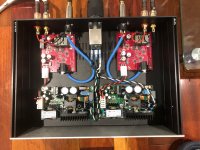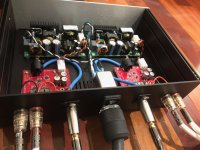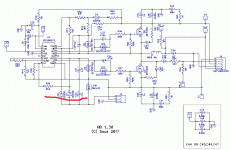It is build from scratch, baseret on a fully differential 5th order integrator.
Chip designs will not achieve this level og performance 🙂
Performance has been verified on my Audio Precision System.
Chip designs will not achieve this level og performance 🙂
Performance has been verified on my Audio Precision System.
Hint - use one diode for H and one for L bustup
I don't understand 😕
Please explain 🙂
Sorry for my short reply about the IRS20957. Was on my way out.
The gatedrive IC is not that critical. IRS20957 is used, because it contains a great short circuit protection.
The most critical part about gatedrive is turning the gate off. On time is not that critical, but you need to turn off faster that fast.
Therefore the IRS20957 is followed a discrete buffer, with higher off-drive current. Maybe the SI8244 will actually be better, due to higher gatedrive current.
Many DIY'ers are trimming the deadtime to achieve better THD. This will help, but not that much. Also, if the THD is depending on perfect deadtime, it will change over time/temperature.
The best way to achieve low THD, is in the control-loop.
This is a 5th order modulator, with at dual-loop-kind-of control-loop. This means, that special requirements for deadtime matching.
Newly completed build DIY Orchard Audio Starkrimson 150W GaN (Gallium Nitride Stereo Amplifier) so far so good both channels are working. It sounded really good plenty of power driving the Triangle Borea BR3 8ohms 90db sensitivity speakers. The clarity and details are amazing and very good soundstage. Source of music BlueSound Node2i TIDAL MQA ---> Parasound ZPre3 Preamp ---> Starkrimson Amp. I need to find a preamp with XLR to get the most out of this amp. 🙂
Attachments
Lovely amp �� well done and clean setup.
Did you compare these bosc modules vs any high end tpa3255 amp (Drmordor xrk or jlester) ?
Did you compare these bosc modules vs any high end tpa3255 amp (Drmordor xrk or jlester) ?
Thank you Daniboun. This was my first Class D amp and I was reading reviews who built it on this forum and recommended this BOSC module. In my opinion very powerful amp and clarity,details and soundstage is amazing. I have this amp driving the Triangle Borea BR3 90db sensitivity speakers and it is loud.
Newly completed build DIY Orchard Audio Starkrimson 150W GaN (Gallium Nitride Stereo Amplifier) so far so good both channels are working. It sounded really good plenty of power driving the Triangle Borea BR3 8ohms 90db sensitivity speakers. The clarity and details are amazing and very good soundstage. Source of music BlueSound Node2i TIDAL MQA ---> Parasound ZPre3 Preamp ---> Starkrimson Amp. I need to find a preamp with XLR to get the most out of this amp. 🙂
Really nice build. I’m far from an expert so it may make no difference, but if it were me I’d considering spinning the right hand module 180 degrees so you can run the mains up through middle next to the power feed for the left hand module. I know this would ruin the symmetry but I’d want to keep the mains away from the audio input. I’d be worried about introducing interference on that one channel.
Thank you Daniboun. This was my first Class D amp and I was reading reviews who built it on this forum and recommended this BOSC module. In my opinion very powerful amp and clarity,details and soundstage is amazing. I have this amp driving the Triangle Borea BR3 90db sensitivity speakers and it is loud.
No comprise with Bosc, they measure very well )
But I was surprised to see it at the 21st position regarding the ranking of the best amps (source ASR)
SINAD list for 3rd party measured amplifiers - Google Sheets
Sinad @5W / 4 ohms is quite significant of the perception that the human ear can have.
I think this is the basis of this ranking, if I'm not mistaken
Last edited:
That´s quite a humble presentation, looks rather very "pro" to me.New take on a DIY class-D amplifier. This is the prototype, just finished...
Tight layout technique! Hope it works as good as it looks!
I don't understand 😕
Please explain 🙂
Sorry for my short reply about the IRS20957. Was on my way out.
The gatedrive IC is not that critical. IRS20957 is used, because it contains a great short circuit protection.
The most critical part about gatedrive is turning the gate off. On time is not that critical, but you need to turn off faster that fast.
Therefore the IRS20957 is followed a discrete buffer, with higher off-drive current. Maybe the SI8244 will actually be better, due to higher gatedrive current.
Many DIY'ers are trimming the deadtime to achieve better THD. This will help, but not that much. Also, if the THD is depending on perfect deadtime, it will change over time/temperature.
The best way to achieve low THD, is in the control-loop.
This is a 5th order modulator, with at dual-loop-kind-of control-loop. This means, that special requirements for deadtime matching.
For simmetrical
To improve quality you need
1) Small dead time
2) Fast response time
Attachments
New take on a DIY class-D amplifier. This is the prototype, just finished...
The amplifier is based on a 5th order modulator for optimum performance.
Features:
- 400 watt @ 4 ohm
- Peak current limited to 30A
- Distortion levels of below 0,0005% at 1dB below rated power.
- Output noise level 33uV
- Output impedance approx 50uΩ
- Fully differential input
- Gain 30dB
- Input impedance 10kΩ
- IRF DirectFET output devices
- Onboard gatedrive regulator
- PSU requirements: +/- 60VDC (35-65VDC) and +/- 12VDC. All rails are monitored.
- Board size 50mmx80mm (thats smaller than your credit card)
The board includes a full protection circuit:
- +/- 60VDC to low (<35VDC)
- +/- 60VDC to hig (>70VDC) bus pumping
- +/- 12VDC to low (<10VDC)
- Short circuit (Current limited to 30A)
- Large HF signals at output
- Overtemperature (60 degress celcius) - Not likely to happen 🙂
Next updates version will also include protection against output MOSFET failure.
Interesting
Could you please post the gain plot and phase plot as well as the clipping behaviour?
A simulation is ok.
Stein
Hint - use one diode for H and one for L bustup
Yes I do it that way.
That´s quite a humble presentation, looks rather very "pro" to me.
Tight layout technique! Hope it works as good as it looks!
Thanks!!
I always try to keep the layout as compact as possible. Short PCB tracks reduce inductance.
I works just perfect.
For simmetrical
To improve quality you need
1) Small dead time
2) Fast response time
The deadtime has been changed up and down, and it do not really make a difference.
Tweaking 4he deadtime may help in a simple design, where the feedback loop topology will not reduce THD to a desired level.
This design performs similar to the Hypex nCORE and Purifi modules.
Interesting
Could you please post the gain plot and phase plot as well as the clipping behaviour?
A simulation is ok.
Stein
I will... just need to do more tests on the AP.
The group delay is constant within the audio range = zero phase shift. This is one of the main achievements.
Newly completed build DIY Orchard Audio Starkrimson 150W GaN (Gallium Nitride Stereo Amplifier) so far so good both channels are working. It sounded really good plenty of power driving the Triangle Borea BR3 8ohms 90db sensitivity speakers. The clarity and details are amazing and very good soundstage. Source of music BlueSound Node2i TIDAL MQA ---> Parasound ZPre3 Preamp ---> Starkrimson Amp. I need to find a preamp with XLR to get the most out of this amp. 🙂
Very nice.
This is a very nice unit to do RCA to XLR (tested on ASR):
Hifi Precision two-channel Single-ended RCA to balanced XLR converter L16-15 | eBay
Really nice build. I’m far from an expert so it may make no difference, but if it were me I’d considering spinning the right hand module 180 degrees so you can run the mains up through middle next to the power feed for the left hand module. I know this would ruin the symmetry but I’d want to keep the mains away from the audio input. I’d be worried about introducing interference on that one channel.
Thank You! You got a point there to avoid interference and the symmetry is not critical once I put the top cover no one will see it. I will do that per your suggestion. 🙂
- Home
- Amplifiers
- Class D
- Class D Amp Photo Gallery


